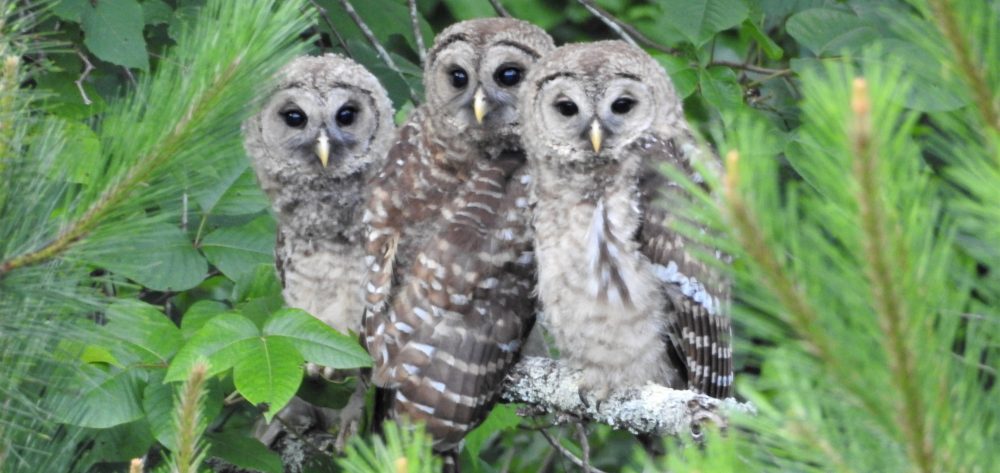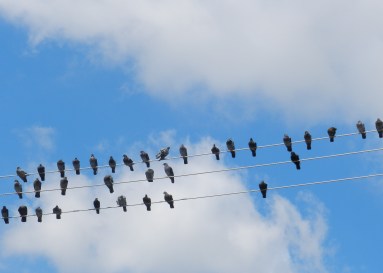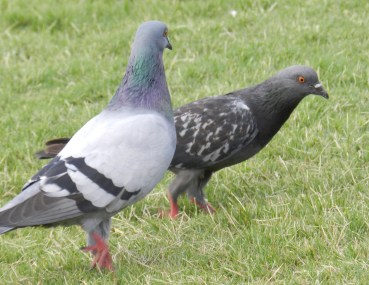Recently, I had the pleasure of “bird-sitting” a charming pigeon named Martha. Found on the ground with an untreatable injury and unable to fly, she was deemed non-releasable at the wildlife rehabilitation center where I volunteer (AWARE). Sadly, for most birds, this prognosis requires humane euthanasia, as wild birds are generally easily stressed and not suited for a life in captivity.* Well-adapted to living in proximity to humans, however, rescued pigeons often fair quite well, and because they are non-native to North America and not protected by the Migratory Bird Treaty Act, they are one of the few wild birds that can legally be kept as a pet. Many people would ask, “who would want a pigeon for a pet?!” Indeed, the pigeon is a much maligned bird, often referred to as a “winged rat.” Luckily for this particular pigeon, my friend Susie, a high school science teacher, wanted to give her a home and to introduce Martha to her students to foster an appreciation for birds and the environment. I enjoyed briefly having this calm, curious bird as a guest in my home and at my office at Atlanta Audubon Society (where she was, not surprisingly, a big hit) until Susie could pick her up. Having also worked closely with pigeons in rehab, I can tell you that they are smart, personable, and beautiful birds, and they have a rich and fascinating history.
Determining the exact historical range of pigeons, also known as Rock Doves, is nearly impossible, but fossil evidence in Israel confirms they have been around for more than 300,000 years. They have been associated with humans for at least 5,000 years, having been raised for food, used as racing or homing pigeons, or kept as fancy pets (bred in a wide variety of color patterns, ranging from pure white, to rust, to slaty-blue). Pigeons in the United States are feral descendants of escaped or released domesticated pigeons; truly wild pigeons exist only in Europe, North Africa, and western Asia, where they typically dwell on rocky coastal cliffs. The birds we see in our cities have adopted the artificial “cliff” faces created by tall buildings and bridges for nesting and roosting, the best available substitute for their natural habitat.
Pigeons are smart and adaptable. Studies have shown that they can recognize human faces, learn the alphabet, and pass the self-recognition test when looking in a mirror, and their navigational abilities have been prized for thousands of years. In fact, selectively bred homing pigeons have the amazing ability to return to their homes when displaced 2,000 miles or more. They’ve served as long-distance messengers and as prized athletes in international races. Such notable figures as Genghis Khan and Julius Caesar used homing pigeons to carry important messages, and the Greeks used pigeons to send news of Olympic victories. One of the most famous pigeons in U.S. history, Cher Ami, saved 194 American troops trapped behind enemy lines during World War I by delivering a message indicating their location. In spite of being shot in the chest and losing a leg, Cher Ami delivered the life-saving message before she expired. She was awarded the French War Cross for her service and is enshrined in the Smithsonian Museum. The incredible navigational abilities of pigeons are not fully understood, but scientists believe they rely on a number of extraordinary capabilities, including the ability to hear infrasound (like the sound of the ocean hundreds of miles away), the ability to use olfactory cues (they follow their nose), and a sensitivity to the earth’s magnetic field (think built-in compass system).
If you take the time to look closely, pigeons are beautiful, too, and have a number of endearing qualities. Even your “run-of-the-mill” pigeon dons a spectrum of vibrant, iridescent color including purples, bronzes, and greens, and each bird has its own unique markings. Adult pigeons have striking orangey-red eyes, and who can resist those pink feet! Pigeons are strong and graceful in flight, too. They have been clocked at close to 100 miles an hour and are surprisingly acrobatic. Watch closely the next time you are stopped at a traffic light with a flock of pigeons taking wing. On the “personal” side, pigeons are faithful mates and devoted parents. They form life-long monogamous pairs and display affection to each other. Both parents play an active role incubating their eggs and feeding their young. Newly hatched pigeons (squabs) are fed by both parents for the first few days through regurgitation of “crop milk” (not to be confused with milk made by mammals; never feed milk to birds as they cannot digest it!) and are gradually introduced to seeds. Parental care continues until the young are nearly grown, which explains why baby pigeons are rarely seen.
This month marked the 100th anniversary of the extinction of the Passenger Pigeon, a related species that once darkened the skies for hours as they passed overhead in flocks of millions of birds. In just a few decades, humans drove this bird to extinction, the largest human-caused extinction in history. (Here is a fascinating and stark account of the extinction of the Passenger Pigeon: Why the Passenger Pigeon Went Extinct.) Let’s hope we have learned a lesson. The last surviving bird was a captive named Martha (in whose honor I suggested the name for Susie’s bird). Let’s hope we’ve learned a lesson. Common as they may be, today’s feral pigeons deserve our compassion and respect, or they too may face an unthinkable fate. If you’ve been following my blog, you know that I have a special fondness for animals that are maligned and misunderstood—like opossums, coyotes, vultures, and crows. I hope that by reading you will begin to rethink these unique and wonderful creatures.

The beautiful Passenger Pigeon, which once darkened the skies with flocks of millions of birds, went extinct 100 years ago this month as a result of human over-exploitation. Let’s hope we have learned a lesson. Image courtesy of the Cornell Lab of Ornithology.
*Some exceptions are large birds of prey and members of the crow family, which can sometimes adapt to living with humans and can make excellent wildlife ambassadors with proper enrichment and training (see My Friend, Edgar Allen Crow). These birds, however, are protected by the Migratory Bird Treaty Act, which “makes it illegal for anyone to take, possess, import, export, transport, sell, purchase, barter, or offer for sale, purchase, or barter, any migratory bird, or the parts, nests, or eggs of such a bird except under the terms of a valid permit issued pursuant to Federal regulations” and includes all species native to the United States or its territories. Anyone wishing to keep a wild bird must obtain a permit from the U.S. Fish and Wildlife Service.



